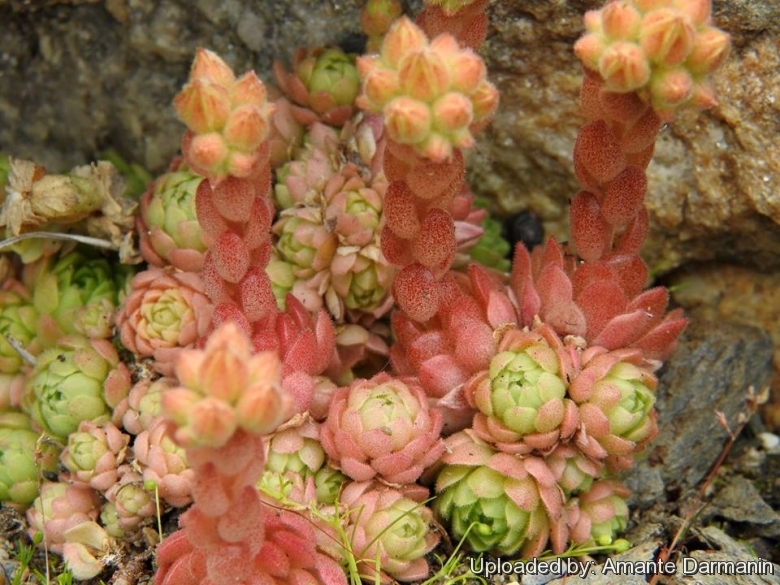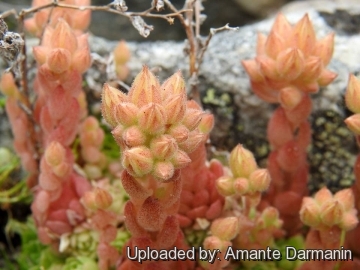Accepted Scientific Name: Rosularia sempervivum subs. libanotica (Labill.) Eggli
Monogr. Study Gen. Rosularia (Crassulac.) 93 (1988)

Orostachys libanotica (Rosularia sempervivum subs. libanotica) Photo by: Amante Darmanin
Tromso Botanical garden, Norway. 10/07/2017
Origin and Habitat: Rosularia sempervivum subs. libanoticaSN|34679]]SN|34679]] is widespread on the rocks of the upper regions of Lebanon and Antilebanon, Israel (Upper and Lower Galilee, Mt. Carmel, Gilead. Area), Southern Turkey, Western Syria, Western Jordan and Iraq.
Altitude range: 100-2400 metres above sea level.
Habitat and ecology: This species grows in rocky macchie, in woods, on walls and and in basic rock crevices.
Synonyms:
See all synonyms of Rosularia sempervivum
Common Names include:
ENGLISH: Lebanon Rosularia, Lebanon Navelwort
Description: Rosularia sempervivum subs. libanotica (syn: Rosularia libanotica) is a perennial, glabrous or pubescent, glandular, succulent up to 10-30 cm tall. The size of its different parts is variable. The generic name of this plant is related to the rosette-like arrangement of basal leaves.
Rosettes: Flattish or with more or less semierect leaves, 2.5-4(-9) cm in diameter. Offsets sessile or 2-3 cm stalked. Flowering rosettes persistent.
Leaves: Rosulate, fleshy, sessile, oblong-truncate to spatulate, tapered at base, with round or emarginate apex, fresh green, seldom glaucous, 2-4(-6) cm long, younger leaves densely glandular-hairy to glabrous and with resinous scent, margin glandular, ciliolate or slightly denticulate. Cauline leaves reduced, oblong-linear.
Inflorescences. The inflorescence is a, loose 2-20-flowered racemose panicle, on a lateral, densely glandular-hairy or glabrous, scape-like stalk 10-20(-30) cm tall, made of 6-10 side branches. Pedicels longer than calyx
Flowers: White to pink, 7-10 mm, funnel-shaped and opening more or less widely. Calyx (3-)4-5 mm long, cylindrical-conical, lobes acute- acuminate, with reflexed tip. Corolla campanulate or urceolate (6-)8-10(-12) mm in diameter, up to two and a half times as long as calyx, white to rose-pink, tubular, cleft to about half its length into 5 petals, these oblong-lanceolate, mucronate, recurved, pale pink with slightly darker venation. Anthers yellow. Nectariferous scales quadrate to oblong-linear, erect, obtuse, emarginate.
Bloming season. Spring (from March-April to May-June).
Fruits (follicles): About 4 mm long, ovate to oblong-lanceolate, gradually tapering into a style, shortly glandular, often becoming glabrous, not ciliate at margin. Styles 0-7-2 mm, recurved or straight.
Seeds: Oblong-ovate to oblong-linear, striate.
Taxonomy notes: The subs. libanotica is part of a very variable and difficult complex of taxa. It is not clear whether Syrian and Lebanese material can be fitted unequivocally into the Turkish material. Subs. libanotica is is reminiscent of subsp. pestalozzae, but readily distinguished by its larger and more widely opening flowers. Rosularia kesrouanensis is tentatively included here as a synonym; it is only known from the type and seems to represent a diminutive form of this taxon.
More...Subspecies, varieties, forms and cultivars of plants belonging to the
Dorstenia benguellensis is extremely variable and forms a complex (The several synonyms refers to previously described species, so similar and intermingled that it is almost impossible to name them accurately without knowing where they come from.) It is not surprising to have caused so much difficulty, because you can find plants with slightly different characteristics growing cheek by jowl in many parts of the areal.
Bibliography: Major references and further lectures
1) Michael Zohary, Naomi Feinbrun-Dothan, "Flora Palaestina: Equisetaceae to Moringaceae". 2 v, Israel Academy of Sciences and Humanities, 1972
2) Urs Eggli, "Illustrated Handbook of Succulent Plants: Crassulaceae", Springer Science & Business Media, 06 December 2012
3) Michael Zohary, Chaia Clara Heyn, D. Heller, "Conspectus florae orientalis: an annotated catalogue of the flora of the Middle East", Parte 1, Israel Academy of Sciences and Humanities, 1980
4) Peter Hadland Davis, James Cullen, M. J. E. Coode, "Flora of Turkey and the East Aegean Islands", Volume 4, University Press, 1965 ? 657
5) Moustapha Nehme, "Wild Flowers of Lebanon", National Council for Scientific Research, 1978
More... Rosularia libanotica. Tromso Botanical garden, Norway. 10/7/17 (Rosularia sempervivum subs. libanotica) Photo by: Amante Darmanin
Rosularia libanotica. Tromso Botanical garden, Norway. 10/7/17 (Rosularia sempervivum subs. libanotica) Photo by: Amante DarmaninSend a photo of this plant.The gallery now contains thousands of pictures, however it is possible to do even more. We are, of course, seeking photos of species not yet shown in the gallery but not only that, we are also looking for better pictures than those already present.
Read More...












